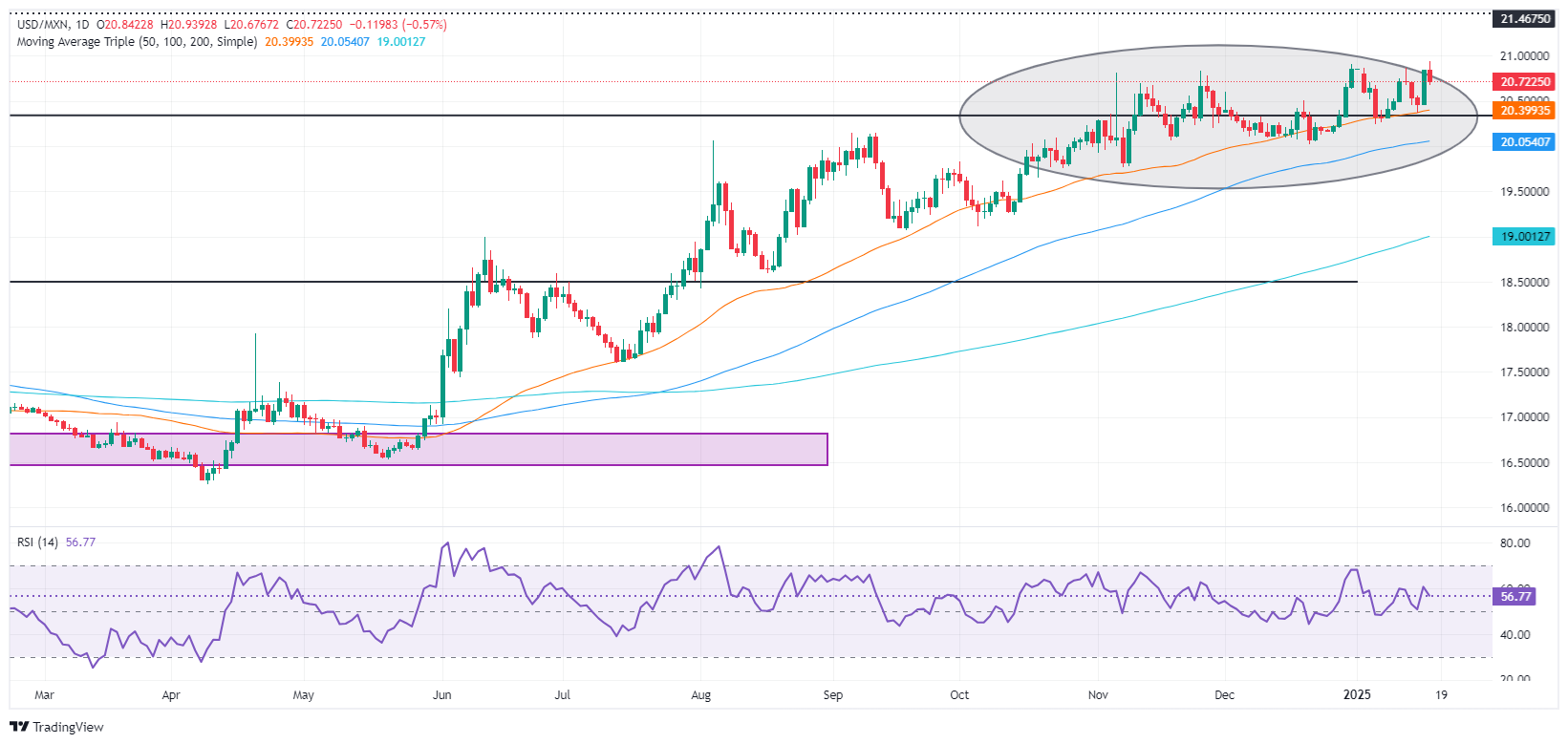- Mexican Peso recovers as China's 5% GDP growth for 2024 boosts global sentiment.
- EU-Mexico trade agreement revival pre-Trump inauguration boosts Peso optimism.
- IMF and World Bank predict modest Mexican growth in 2025, cite domestic and US political risks.
The Mexican Peso (MXN) stages a recovery after weakening to a new yearly low of 20.93 and appreciates against the Greenback due to an improvement in risk appetite following China’s upbeat GDP figures. The USD/MXN trades at 20.72, down 0.38%.
During the Asian session, China announced its Gross Domestic Product (GDP) rose by 5% in 2024, meeting the government’s goal for the year. Other data showed that China’s industrial output outpaced retail sales while the unemployment rate increased.
Consequently, risk-sensitive currencies like the Mexican Peso rose. The Peso extended its rally following a Reuters report that the European Union (EU) and Mexico revived a stalled free trade agreement on Friday, days ahead of Donald Trump’s inauguration.
Meanwhile, the International Monetary Fund (IMF) and the World Bank updated their projections of the Mexican economy. The former estimates a 1.4% growth in 2025, while the latter foresees a slightly optimistic 1.5% increase. Both institutions mentioned that the economy faces risks, such as uncertainty over recently approved reforms and Trump’s return to the White House.
Next week, Mexico’s economic docket will feature Retail Sales, mid-month January inflation data and a proxy for GDP, Economic Activity for November.
Daily digest market movers: Mexican Peso advances as traders await Trump’s inauguration
- The Mexican Peso shrugs-off concerns ahead of Trump’s inauguration as the USD/MXN retreats below 20.80.
- However, the Mexican currency is not out of the woods. The divergence between the Banco de Mexico (Banxico) and the Federal Reserve (Fed) hints that further upside in USD/MXN lies ahead.
- Economists polled by Reuters revealed that GDP will grow 1.2% in 2025, compared to 1.6% last year. Additionally, they foresee Banco de Mexico (Banxico) cutting interest rates by at least 150 basis points to 8.50% by the end of the year.
- In the Fed’s latest Summary of Economic Projections (SEP), officials estimate they will cut interest rates by 50 basis points.
- US Industrial Production increased by 0.9% MoM, higher than estimates of 0.3%, crushing November’s 0.2% expansion.
- Money market futures had priced in 42.5 bps of Fed rate cuts in 2025, according to CME FedWatch Tool data.
USD/MXN technical outlook: Mexican Peso rises as USD/MXN dips below 20.80
USD/MXN is ongoing a pullback after hitting a new yearly high of 20.93. Momentum remains bullish as depicted by the Relative Strength Index (RSI), but expect a test of the 50-day Simple Moving Average (SMA) if the pair slumps below 20.50. A breach of the latter will expose the 50-day SMA at 20.36, ahead of challenging the 100-day SMA at 20.02.
Conversely, if buyers push the USD/MXN above 20.90, this could pave the way towards hitting the 21.00 psychological barrier. If cleared, the next resistance will be the March 8, 2022 peak at 21.46, followed by 21.50 and the 22.00 psychological level.
Mexican Peso FAQs
The Mexican Peso (MXN) is the most traded currency among its Latin American peers. Its value is broadly determined by the performance of the Mexican economy, the country’s central bank’s policy, the amount of foreign investment in the country and even the levels of remittances sent by Mexicans who live abroad, particularly in the United States. Geopolitical trends can also move MXN: for example, the process of nearshoring – or the decision by some firms to relocate manufacturing capacity and supply chains closer to their home countries – is also seen as a catalyst for the Mexican currency as the country is considered a key manufacturing hub in the American continent. Another catalyst for MXN is Oil prices as Mexico is a key exporter of the commodity.
The main objective of Mexico’s central bank, also known as Banxico, is to maintain inflation at low and stable levels (at or close to its target of 3%, the midpoint in a tolerance band of between 2% and 4%). To this end, the bank sets an appropriate level of interest rates. When inflation is too high, Banxico will attempt to tame it by raising interest rates, making it more expensive for households and businesses to borrow money, thus cooling demand and the overall economy. Higher interest rates are generally positive for the Mexican Peso (MXN) as they lead to higher yields, making the country a more attractive place for investors. On the contrary, lower interest rates tend to weaken MXN.
Macroeconomic data releases are key to assess the state of the economy and can have an impact on the Mexican Peso (MXN) valuation. A strong Mexican economy, based on high economic growth, low unemployment and high confidence is good for MXN. Not only does it attract more foreign investment but it may encourage the Bank of Mexico (Banxico) to increase interest rates, particularly if this strength comes together with elevated inflation. However, if economic data is weak, MXN is likely to depreciate.
As an emerging-market currency, the Mexican Peso (MXN) tends to strive during risk-on periods, or when investors perceive that broader market risks are low and thus are eager to engage with investments that carry a higher risk. Conversely, MXN tends to weaken at times of market turbulence or economic uncertainty as investors tend to sell higher-risk assets and flee to the more-stable safe havens.
Disclaimer: The information on this blog is for educational purposes only and should not be considered financial or investment advice. Trading involves high risk, and you should only trade with money you can afford to lose. Past performance is not indicative of future results. We do not guarantee the accuracy of the content and are not liable for any losses. Articles are sourced from FxStreet, and we do not take responsibility for any inaccuracies or opinions expressed.
 17-01-2025
17-01-2025
